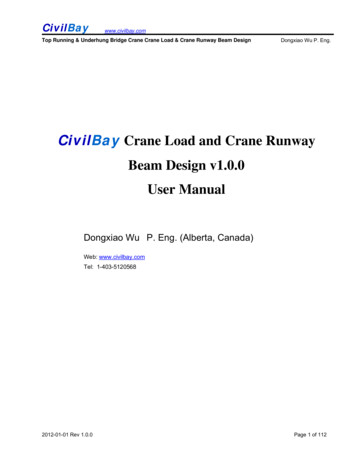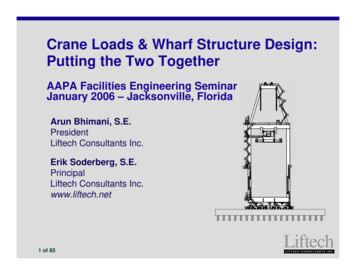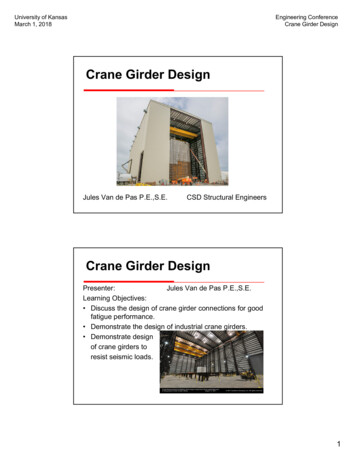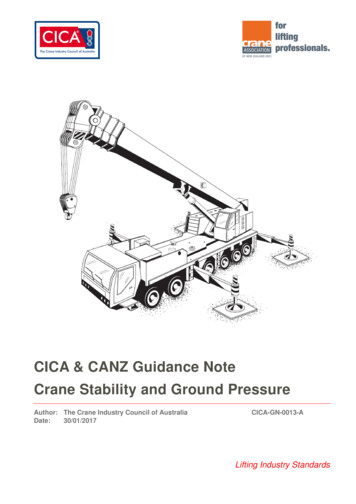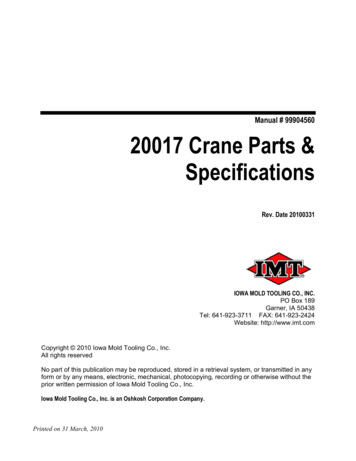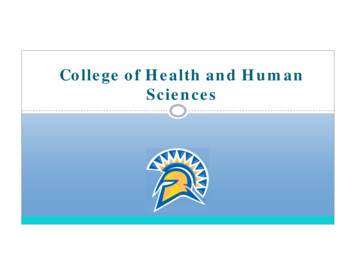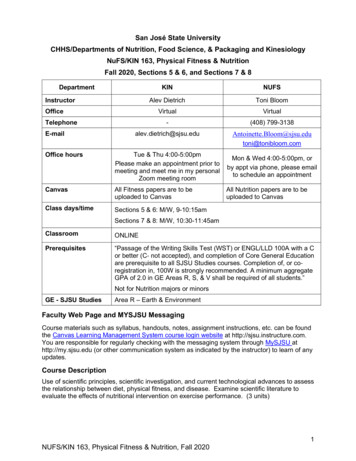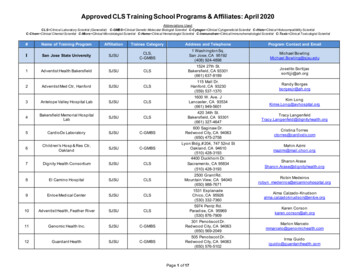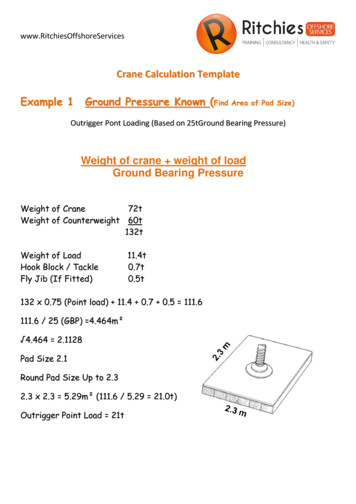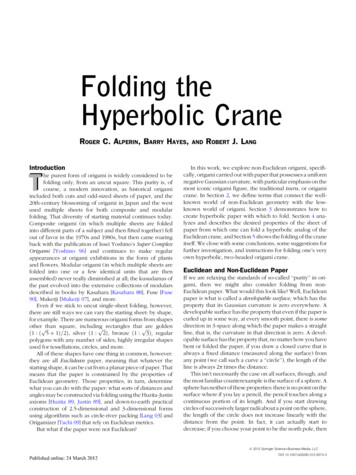
Transcription
Folding theHyperbolic CraneROGER C. ALPERIN, BARRY HAYES,IntroductionThe purest form of origami is widely considered to befolding only, from an uncut square. This purity is, ofcourse, a modern innovation, as historical origamiincluded both cuts and odd-sized sheets of paper, and the20th-century blossoming of origami in Japan and the westused multiple sheets for both composite and modularfolding. That diversity of starting material continues today.Composite origami (in which multiple sheets are foldedinto different parts of a subject and then fitted together) fellout of favor in the 1970s and 1980s, but then came roaringback with the publication of Issei Yoshino’s Super ComplexOrigami [Yoshino 96] and continues to make regularappearances at origami exhibitions in the form of plantsand flowers. Modular origami (in which multiple sheets arefolded into one or a few identical units that are thenassembled) never really diminished at all; the kusudamas ofthe past evolved into the extensive collections of modularsdescribed in books by Kasahara [Kasahara 88], Fuse [Fuse90], Mukerji [Mukerji 07], and more.Even if we stick to uncut single-sheet folding, however,there are still ways we can vary the starting sheet: by shape,for example. There are numerous origami forms from shapesotherpthansquare, includingpffiffiffirectangles thatpareffiffiffiffiffiffi goldenð1 : ð 5 þ 1Þ 2Þ, silver ð1 : 2Þ, bronze ð1 : 3Þ, regularpolygons with any number of sides, highly irregular shapesused for tessellations, circles, and more.All of these shapes have one thing in common, however:they are all Euclidean paper, meaning that whatever thestarting shape, it can be cut from a planar piece of paper. Thatmeans that the paper is constrained by the properties ofEuclidean geometry. Those properties, in turn, determinewhat you can do with the paper: what sorts of distances andangles may be constructed via folding using the Huzita-Justinaxioms [Huzita 89, Justin 89], and down-to-earth practicalconstruction of 2.5-dimensional and 3-dimensional formsusing algorithms such as circle-river packing [Lang 03] andOrigamizer [Tachi 09] that rely on Euclidean metrics.But what if the paper were not Euclidean?ANDROBERT J. LANGIn this work, we explore non-Euclidean origami, specifically, origami carried out with paper that possesses a uniformnegative Gaussian curvature, with particular emphasis on themost iconic origami figure, the traditional tsuru, or origamicrane. In Section 2, we define terms that connect the wellknown world of non-Euclidean geometry with the lessknown world of origami. Section 3 demonstrates how tocreate hyperbolic paper with which to fold. Section 4 analyzes and describes the desired properties of the sheet ofpaper from which one can fold a hyperbolic analog of theEuclidean crane, and Section 5 shows the folding of the craneitself. We close with some conclusions, some suggestions forfurther investigation, and instructions for folding one’s veryown hyperbolic, two-headed origami crane.Euclidean and Non-Euclidean PaperIf we are relaxing the standards of so-called ‘‘purity’’ in origami, then we might also consider folding from nonEuclidean paper. What would this look like? Well, Euclideanpaper is what is called a developable surface, which has theproperty that its Gaussian curvature is zero everywhere. Adevelopable surface has the property that even if the paper iscurled up in some way, at every smooth point, there is somedirection in 3-space along which the paper makes a straightline, that is, the curvature in that direction is zero. A developable surface has the property that, no matter how you havebent or folded the paper, if you draw a closed curve that isalways a fixed distance (measured along the surface) fromany point (we call such a curve a ‘‘circle’’), the length of theline is always 2p times the distance.This isn’t necessarily the case on all surfaces, though, andthe most familiar counterexample is the surface of a sphere. Asphere has neither of these properties: there is no point on thesurface where if you lay a pencil, the pencil touches along acontinuous portion of its length. And if you start drawingcircles of successively larger radii about a point on the sphere,the length of the circle does not increase linearly with thedistance from the point. In fact, it can actually start todecrease; if you choose your point to be the north pole, then 2012 Springer Science Business Media, LLCDOI 10.1007/s00283-012-9274-3
the circles around the pole are lines of latitude. As you getfarther and farther from the north pole, the rate at which linesof latitude increase in length slows down and eventuallyreverses, with the circles becoming smaller and smaller asthey approach the south pole.The surface of a sphere has what is called positiveGaussian curvature. In fact, it has a property that makes itvery desirable for origami: its Gaussian curvature is everywhere constant. That means if you were to cut a piece ofpaper from one part of a sphere and cut another piece ofpaper from another part of the sphere, you could place thetwo anywhere on the sphere with all points in contact—witheach other, and with the sphere. And this would be the caseno matter what the orientation of the paper might be.Ordinary Euclidean paper has zero Gaussian curvatureeverywhere, so it has constant Gaussian curvature, too, andthis property gives rise to the notion of metric foldable: theidea that one can make a fold in the paper in such a way thatall of the layers on one side of the fold are in contact with all ofthe layers on the other side of the fold.1So, a Euclidean sheet of paper has constant (zero)Gaussian curvature everywhere, and that means that it ispotentially metric foldable; it is possible to create folds, ornetworks of folds, such that all of the layers of the folded resultare congruent to each other and to some other zero-Gaussiancurvature surface, such as a plane, cylinder, or tipless cone.Curvature is preserved by bendings or local isometries of thesurface; Gauss’s Theorem Egregium asserts that curvature isintrinsic and can be obtained from measurements on thesurface, however it may be put into space [Treiberg 08].We can now extend the definition of metric foldability tonon-Euclidean paper:cut from a sphere is metric foldable (in this sense) if the foldedresult can be pressed smoothly against some constantcurvature sphere—and, it’s pretty clear in fact, that this mustbe a sphere with the same curvature as the starting sheet.But a sphere is not the only surface with nonzero constantGaussian curvature.Among its many properties is the one that as you drawlarger and larger circles about a point, the size of the circleincreases, but sublinearly. The opposite is possible, however:there are surfaces for which if you draw circles about a pointwith larger and larger radii, the length of the circle increasessuperlinearly. Such surfaces give rise to a geometry known ashyperbolic geometry.Hyperbolic geometry was independently invented byBolyai and Lobachevsky. On a hyperbolic surface, the sum ofthe angles of a triangle is always less than 180 (on aEuclidean surface, the sum is exactly 180 ; on a sphere, thesum is always greater). Hyperbolic geometry satisfies all ofEuclid’s postulates except the parallel postulate: given a pointP not on a line L, instead of there being exactly one linethrough P that does not intersect L (as in the Euclidean case),there are infinitely many. This change gives rise to newproperties of origami constructions when undertaken inhyperbolic geometry (see [Alperin 11]). But it can also giverise to new properties in folded origami design. Hyperbolicgeometry is the geometry of a complete, simply connectedsurface of constant negative Gaussian curvature.A surface has negative Gaussian curvature at a point if thesurface curves down in one direction and curves upward inthe perpendicular direction. Or, in other words, it is shapedlike a potato chip. An example of such a surface is thehyperbolic paraboloid shown in Figure 1, which has thesimple equationD EFINITION 1 A constant-curvature piece of origami isz ¼ x 2 y2 :metric foldable if all layers are congruent to a surface of (thesame) constant Gaussian curvature.This definition will clearly cover the case of a sphericalpiece of origami; an origami fold made from a sheet of paperð1ÞThe hyperbolic paraboloid is familiar to many origamienthusiasts, as that is the name of a fairly well-known origamimodel composed of pleated concentric Waterbomb Bases,recently proven by Demaine, et al. to ‘‘not exist’’ (at least, notwithout the addition of extra creases) [Demaine, et al. 11].AUTHORS.ROGER C. ALPERIN grew up in Miami,Florida, received a degree in mathematicsfrom the University of Chicago, andreceived a Ph.D. degree from Rice University. His main interest is algebra and itsinteractions with low-dimensional topologyand geometry. For the last 25 years he hastaught at San Jose State University whileenjoying life and hiking in the Bay Area.San Jose State UniversitySan Jose, CAUSAe-mail: alperin@math.sjsu.edu1BARRY HAYES learned how to fold a papercup from his father. He obtained his Ph.D. inComputer Science from Stanford University,with the paper to prove it, lives in Palo Alto,and works at Stanford’s LOCKSS Project. Hecan still fold a paper cup.Stanford UniversityStanford, CAUSAe-mail: bhayes@cs.stanford.eduMetric foldability is similar to the notion of flat foldability common in the origami literature (see, e.g., Hull [Hull 02]), but flat foldability typically encompasses both metric conditionsand conditions on layer ordering that enforce non-self-intersection. Metric foldability does not consider questions of self-intersection, and so is a somewhat weaker condition.THE MATHEMATICAL INTELLIGENCER
Figure 1. Plot of a hyperbolic paraboloid, a model of nonconstant negative Gaussian curvature.Figure 2. Plot of half of a pseudosphere (truncated at the top).One could imagine making a sheet of paper of this shape(perhaps by dampening a potato chip until it gets soft?) andfolding something from it, but the hyperbolic paraboloid hasa problem: it has negative Gaussian curvature, but it does nothave constant Gaussian curvature. In fact, its curvature ishighest in the very middle and then drops off toward theedges. As one proceeds farther and farther from the center,the value of the curvature becomes smaller and smaller, andso the paper becomes more and more Euclidean away fromthe middle. The problem with nonconstant Gaussian curvature is that the paper cannot be folded congruently to itselfexcept along a few special lines of symmetry. We need asurface with constant negative curvature, so that fold linescan, in principle, run any direction through any point. So thehyperbolic paraboloid does not work as a starting surface fornon-Euclidean origami.To obtain a surface that has constant negative Gaussiancurvature, we turn to another model: the pseudosphere, socalled because (like a sphere) it has constant Gaussian curvature, but (unlike a sphere) its curvature is negative. Thepseudosphere has the �ffi ��ffiffiffiffiffiffiffiffiffiffið2Þz ¼ sech 1 x 2 þ y2 1 ðx 2 þ y 2 Þ;and its top half (f , a hemipseudosphere) is shown inFigure 2; the bottom half (f-) is its mirror image in a horizontal plane. Going forward, we will only be concernedwith the upper hemipseudosphere.A pseudosphere has constant negative curvature. Becauseit is constant, if you cut a patch of a pseudosphere, you canslide it around on the surface of the pseudosphere keeping allpoints in contact with the pseudosphere at all times. You canturn it around, slide it up and down, anything you like—butyou can’t cross the sharp rim, where there is a singularity inthe curvature. The sliding patch may, as it slides about,overlap itself: if you cut a large patch from near the base andthen slide it upward, the higher it goes, the more tightly it willwrap around the central spire until, eventually, it will begin tooverlap itself. And of course, it must bend as it slides around(unlike spherical patches, which can slide on a spherewithout bending). But the important thing is that pieces ofpseudosphere can slide on a pseudosphere without stretching. And that means that we can apply our notion of metricfoldability to pseudospherical, hyperbolic paper.or a parameterization f : ½0; 1Þ ½ p; pÞ ! R3 given byf ðu; vÞ ¼ ðsechu cos v; sechu sin v; ðu tanh uÞÞ;ð3Þ.ROBERT J. LANG has Caltech and Stanforddegrees in Electrical Engineering and AppliedPhysics and folds paper for a living. A lifelonginfection with a love of mathematics keepshim finding connections between origamiand mathematics from a home base inAlamo, California. His website is http://www.langorigami.com.Langorigami.comAlamo, CAUSAe-mail: robert@langorigami.com2Pseudospherical PaperOne can, of course, analyze origami with hyperbolic paper inpurely mathematical terms, but what makes this probleminteresting is the practical possibilities: we can, actuallymake hyperbolic paper and carry out folding experimentswith it.To do so, we need two things: (a) a hyperbolic sheet ofpaper, (b) a hyperbolic desk to fold on.Well, we don’t actually need the second part. We can foldEuclidean paper in midair (in fact, origami master Yoshizawahas famously advocated midair folding for all folders,although video evidence reveals a suspiciously desk-likefolding surface under his own paper at times2).When folding in midair, one creates a fold by pinching thepaper at a point in the direction of the fold and then continuing to flatten the pinch along a line without twisting orchanging the direction. This is the same as folding along ageodesic of the surface, a curve on the surface whose nontangential component of acceleration is zero. But physicallyperforming this manipulation in midair without unintentionally incorporating small lateral accelerations is difficult,See, for example, the 2009 documentary film Between the Folds. 2012 Springer Science Business Media, LLC
and if the fold is not along a geodesic, the layers on oppositesides of the fold will not lie flat against one another. The resultwill not be metrically flat.With Euclidean paper, it is much easier to create a metrically flat fold if, after we have begun a fold, we press it flatagainst a Euclidean flat table. With non-Euclidean paper, wewill also wish to press the paper ‘‘flat’’ after folding, but fornon-Euclidean paper, ‘‘flat’’ means ‘‘congruent to a surfacewith the same Gaussian curvature as the paper.’’ Thus, wewill fold our pseudospherical paper while seated at apseudospherical desk, against which we will fold.Even before making a fold, however, we must acquirepseudospherical paper. A quick check of the local art storesrevealed no pseudospherical paper to be found. We mustmake it ourselves.The usual way of making paper by hand uses a meshscreen, which is dipped into a vat of paper slurry, then is liftedout; the water drains through the mesh, leaving behind a thinlayer of paper fibers on the mesh. This layer is then invertedonto a felt; a stack of paper/felt layers is pressed to mat thefibers and to remove water; and then the resulting layers arestacked between layers of blotter paper and cardboard forfurther pressing and drying. Commercial paper making follows a similar process, but uses mesh belts and rollers torealize a continuous manufacturing process.That presents a whole slew of problems for makinghyperbolic paper, beginning with the very first step. Whenone lifts the mold out of the paper slurry, it is critical that themesh surface remain exactly horizontal; even the slightest tiltcreates variations in paper thickness or even creates holes, asthe paper/water slurry runs off the side, rather than the waterdraining evenly through the mesh.But it is impossible to make a hyperbolic mesh that ishorizontal at every point; if it’s horizontal at every point, thenyou have a Euclidean plane. And since just a few degrees oftilt is enough to ruin a sheet of paper, there would be no wayto pull a hyperbolic sheet with a lot of curvature—even if onehad a hyperbolic mesh.And, of course, the hyperbolic form would need to bereplicated in all of the other elements of the paper-makingprocess. Sounds expensive.There’s another way, though: we could, perhaps, startwith a sheet of Euclidean paper and modify it to make ithyperbolic.How would we modify it? Well, we’d have to give it negative curvature everywhere. We’d have to give it the propertythat, if you draw concentric circles, the ones farther awaybecome longer at a faster rate than linearly. So we could startwith a sheet of paper, fix one point, and then, as we movefarther away, stretch it out so that it becomes larger and larger,doing the stretching at exactly the right rate to keep thenegative curvature constant.This is, in fact, precisely the approach taken by textileartists who knit or crochet hyperbolic surfaces (see, forexample, [Taimina 09], [belcastro and Yackel 07]). By crocheting in concentric circles and strategically adding stitchesas the radius increases, one can obtain the required increasein length, which gives the desired curvature of the resultingsurface. This only works for finite regions of the hyperbolicplane; as Hilbert showed (1901) [Treiberg 03] there is noTHE MATHEMATICAL INTELLIGENCERgeodesically complete smooth immersion of the hyperbolicplane in R3 . However, one can view the crocheted surfaces asconfirmations of the results of Kuipers and Nash (1955–1956)[Treiberg 03] that by sufficiently crinkling the hyperbolicplane one can obtain an embedding into R3 .One could take a similar approach to create an approximation of a hyperbolic surface with paper. One could, forexample, take a sheet of Euclidean paper, cut slits into it, andinsert strategically chosen wedges to give the desired increasein circular length as one moves out from the center. Or, for amore scalable approximation, one could create a hyperbolictiling, joining equilateral triangles with seven triangles at eachvertex, or a tiling of hexagons and heptagons with two of theformer and one of the latter at every vertex. There are manypossibilities of this sort, but they all suffer from a flaw: theyare only approximations of hyperbolic paper. Locally, eachpoint is either Euclidean (in the interior of a tile) or singular(at a vertex); it is only the large-scale average behavior thatapproaches a true hyperbolic surface. What we’d really like todo is distribute the extra length evenly, rather that insert it indiscrete ‘‘chunks’’ within the surface.Even distribution of extra length would imply stretchingthe paper out continuously at its edges as you move fartherand farther away from a central point. The problem there isthat paper doesn’t stretch; it rips.But, one thing paper does do fairly well is ‘‘bunch up.’’Instead of fixing the center and stretching the edges, we couldfix the edges and ‘‘bunch up’’ the center; that would have thesame effect. The amount of bunching is critical, though; itneeds to be just the right amount at every point of the paper.Too much, and the curvature is too large at that point; toolittle, and the curvature is too small. And if the curvature isnonuniform, then one loses the ability to do metrically flatfolding. We need to introduce just the right amount of curvature at every point so that the result is congruent to thehyperbolic desk that we are folding against.So, let’s use the ‘‘desk’’ as a mold; we will take a Euclideansheet of paper and mold it against a hyperbolic form; theresult will be a pseudospherical sheet of paper from whichwe can do true hyperbolic origami.But where do we get a hyperbolic desk? In the old days,this would have been a simple thing to obtain. The pseudosphere is a solid of rotation; its cross section is the tractrix,which has the 4Þz ¼ sech 1 r 1 r 2 ;One could simply create a template of this curve, then giveit to a handy woodworker who could turn it on a lathe. Butnowadays, this is an even simpler thing to obtain. Thanks tothe existence of commercial 3D printing companies such asShapeways (http://www.shapeways.com), one can generatea 3D model in MathematicaTM , upload it to one’s website,and a few weeks later (and a few dollars poorer), one receivesa plastic 3D model of the desired figure.Now, using the hyperbolic form, we create the sheet ofhyperbolic paper. Take a sheet of thin, strong kozo paper andsaturate it with a solution of Carboxymethylcellulose (a sizingagent) and drape it loosely over the pseudosphere. Althoughit will stick near its edges, this leaves enough excess paper in
Figure 3. Left: the plastic pseudosphere. Right: a sheet ofpseudospherical paper after forming and drying.the middle so that it can be smoothed down against thepseudosphere, where the excess paper will gather into irregular pleats across the surface. By smoothing it down completely,it sticks to the surface all the way up, down, and around theform (with the excess paper gathered into a rough flangesticking out from the back). Now let the whole thing dry.After the paper dries, the CMC bonds all of the layers of thepleats firmly together, so that it all behaves like a single sheet.After cutting off all excess that isn’t stuck to the pseudosphere(including the flange on the back side), we have a single sheetthat is congruent to the pseudosphere, extending nearly allthe way around it (there will be a gap where the excess-paperflange is cut away). Then peel the paper off of the pseudosphere. The result is a sheet that has some small variation inthickness over its surface, but has a uniform negative curvature that exactly matches that of the pseudosphere. The moldand resulting sheet are shown together in Figure 3.We now have hyperbolic paper. With a concrete object inhand (well, a cellulose object), it is time to do some folding.Hyperbolic FoldingWhat does a fold look like on hyperbolic paper? Or, to beprecise, what does a metric or flat fold look like? Can any(possibly curved) line on a hyperbolic sheet be folded?We can address this by analogy with Euclidean paper. On aEuclidean sheet, for a fold to be folded flat, it must be straight.It is possible to create a fold line that is curved within thesurface, but if this done, then as the fold is formed, the paperon either side of the fold takes on a curved shape in 3D, and itis not possible to close the dihedral fold angle completely. Infact, the two-dimensional curvature of the fold line and its 3Dcurvature are linked by the dihedral angle of the fold itself[Fuchs and Tabachnikov 99]; as the dihedral angle approaches 180 , the 3D curvature of the fold line becomes infinite,unless the fold line itself is straight. So in Euclidean paper, allfold lines in a flat fold must be straight between vertices.Exactly the same condition must apply with hyperbolicpaper. If we ‘‘blow up’’ a patch of hyperbolic paper to a highmagnification, it begins to look locally flat, and so the samelocal laws as metric flat folding must apply to infinitesimallysmall regions of hyperbolic paper. So on hyperbolic, as wellas Euclidean paper (and spherical paper, too, for that matter),Figure 4. The pseudospherical sheet with a single fold.all metric-foldable fold lines must be straight. Specifically,they must be geodesics.If we fold along a geodesic, then we can achieve ahyperbolic metric fold: the folded layer can lie back on itselfcongruently, so that it touches at all points. An example of thisis shown in Figure 4.Figure 4 shows the paper after making a single (vertical)fold, and it is obvious from symmetry considerations that thetwo layers of the paper must be congruent with each other.What is less obvious, but follows directly from the constantGaussian curvature, is that this fold and the double-layeredpaper could be wrapped around the pseudosphere congruently, in any rotational orientation, without stretching. And,in fact, any metric-fold could be similarly wrapped.So, we have hyperbolic paper, and we can make folds in it.We can make hyperbolic origami. But what hyperbolic shapeshould we make?Ideally, we should fold something that exploits thehyperbolicity in some special way. There’s not much point infolding something that looks pretty much the same as whatyou get with Euclidean paper. We’d like to show off someproperty that comes as part of the hyperbolic geometry.And one property that comes along with hyperbolicgeometry is that there is no such thing as similarity: the geometric properties of polygons depend on the specific size ofthe polygon. The sum of the angles in a triangle is less than180 in hyperbolic space, but it’s not a fixed number; in fact, itcan be made as small as desired, simply by making the triangle larger and larger.Conversely, if instead of fixing the number of sides, we fixthe corner angles, we can increase the number of sides in apolygon simply by making it larger and larger. If we have aquadrilateral whose corner angles are some value a, thenthere is a somewhat larger pentagon whose corner angles area, and a still larger hexagon whose corner angles are a, and soforth and so on, with no limit.This is a very nice property! We can make use of it whenwe get down to the origami problem of constructing a base—a geometric shape that has the same number of flaps as thesubject has appendages.With Euclidean paper, if we want to make a base that has Nequal points coming from the edges of the paper, we mustuse an equilateral N-gon; each corner of the N-gon becomes a 2012 Springer Science Business Media, LLC
Figure 5. Top: Crease patterns for N 4, 5, 6-gons. Bottom: The folded origami bases. Note that the flaps (shaded) becomeshorter and wider as N increases.point. The aspect ratio of each point is related to the cornerangle of its polygon; the larger the corner angle, the shorterand wider each point becomes. Thus, as N increases, thecorner angles increase, approaching 180 , and, for a givennumber of layers in each point, the individual points becomeshorter and stubbier. Furthermore, a larger fraction of thepaper goes into the interior of the N-gon relative to theamount used for the edge points, leading to wasted paper andthickness in the base. Figure 5 illustrates this shortening forN 4, 5, 6-gons. The N 4 shape is the classic Japaneseform called the ‘‘Bird Base,’’ which is the basis of the traditional tsuru, as well as many other origami figures bothtraditional and modern.In an edge-point base, if we want to fix the aspect ratio ofthe points of the base, we need to preserve the corner angle ofthe polygon from which the base is folded. Going from 4 to 5points by going from a square to a pentagon will shorten andwiden all 5 points. John Montroll recognized this tradeoff anddevised an innovative solution to the problem decades ago:his ‘‘Five-Sided Square’’ [Montroll 85]. Imagine dividing asquare into quarters along its diagonals, so that it appears tobe composed of four isoceles right triangles. Now, imaginesplicing in a fifth isoceles right triangle. This results in a shapethat is an equilateral pentagon that has five right-angledcorners. Such a shape does not exist in the Euclidean plane,and indeed, Montroll’s ‘‘Five-Sided Square’’ cannot be flattened into a single layer. But it does solve the problem ofgetting five points whose aspect ratio is the same as thoseobtained from a Bird Base—the basis of the traditional Japanese tsuru, and a host of other origami designs.Montroll’s ‘‘Five-Sided Square’’ is not a hyperbolic surface;it is a Euclidean surface with a single singular point at its center. (Montroll’s brilliant innovation was to find a way to foldthis shape from a single uncut Euclidean square.) But now thatwe have hyperbolic paper in our arsenal, we can do exactlythe same thing without folding. Hyperbolic paper allows oneto cut a real ‘‘Five-Sided Square’’—or, rather, not precisely asquare, but a real five-sided equilateral polygon whose cornerangles, like those of a Euclidean square, are all right angles.THE MATHEMATICAL INTELLIGENCERcBAbaCFigure 6. Schematic of a hyperbolic pentagon with inscribedand circumscribed circles.In fact, we can cut an equilateral/equiangular right-angledpolygon with any number of sides from a sufficiently largesheet of hyperbolic paper. But not necessarily from a sheetformed on a hemipseudosphere, which has finite size.We should work out how much paper a right-angledpolygon requires. A right-angled N-gon can be broken upinto 2N triangles with corner angles fp2 ; p4 ; Np g radians, asillustrated in Figure 6 for a hyperbolic pentagon.The area of a triangle 4 with angles A, B, C in hyperbolicgeometry is given by the excess formulaAreaðMÞ ¼ p A B C:ð5ÞSo the right-angled polygon with N sides, consisting of 2Nsuch triangles, has area 2N pð1 12 14 N1 Þ ¼ pðN2 2Þ,which increases linearly with N.The surface area of the unit pseudosphere is finite, however; in fact, it is 4p (the same as that of a real sphere with theopposite Gaussian curvature), so there is some upper boundon the number of sides of a right-angled polygon cut from ahemipseudosphere. We cannot cut an arbitrarily large polygon from a sheet of finite area (even setting aside the fact thatour mold with the top spine truncated is not even half of a
have the same value of sin /; this, in turn, means that the/-values at the two points on the geodesic must be a pair{/, p - /}. Their v values must differ by some multiple of 2p,which means that the possible values of / at a crossing pointcan take on only discrete values:/c ¼ cos 1Figure 7. A hemipseudosphere with the largest nonoverlapping circle (green). The red and blue lines are radii of thecircle.p2pseudosphere). A right-angled pentagon with area mightwell fit in
purely mathematical terms, but what makes this problem interesting is the practical possibilities: we can, actually hyperbolic paper and carry out folding experiments withit. To do so, we need two things: (a) a hyperbolic sheet of paper, (b) a hyperbolic desk to

